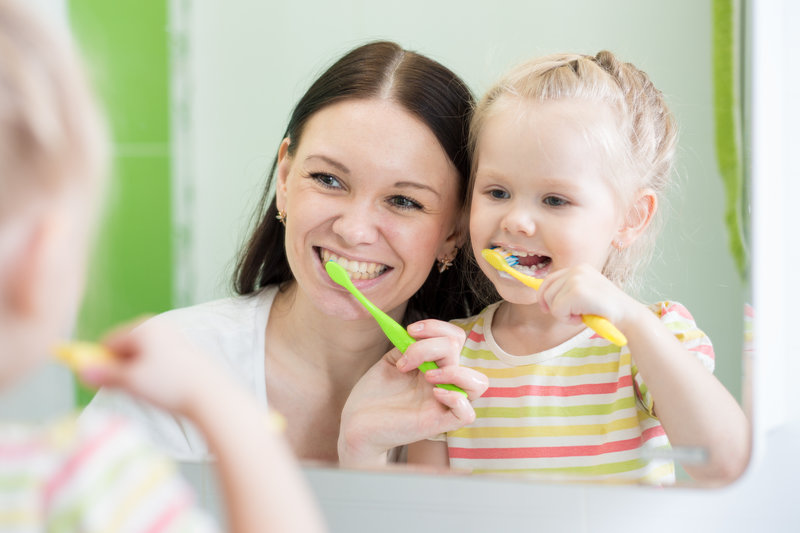The Differences between Adult and Baby Teeth
What Toothbrushes Are Best for You?
October 13, 2017Why It’s Important to Have a Clean Mouth
October 24, 2017
An adult’s mouth is different than a baby’s mouth. A baby’s mouth is comprised of around 20 baby teeth that have many functions to prepare the mouth for adult teeth in the future. They help provide space for adult teeth to come in and provide many opportunities for oral hygiene to be established by the time a child has grown into their permanent teeth. There are many differences between adult teeth and baby teeth such as the hardness of the enamel, how big the teeth are, how many there are, the spacing between them, and more. Find out all the differences between adult and baby teeth and how both should be taken care of throughout life.
All About the Baby Teeth
Babies aren’t born with teeth already in their mouth. This is no surprise to many. Babies actually don’t start to have teeth erupt in the mouth until about 6 months of age. Many infants will have their teeth erupt after this time and some will get a tooth or two very early on. You may notice that an infant’s smile is different from your own. This is mostly due to the size of an infant’s mouth. A baby takes years to grow into a child, then an adolescent, and finally an adult. The body continues to grow with that child, and that growth includes the mouth and jaws.
A child will only have about 20 baby teeth. These will be more spaced out than an adult’s teeth and they will be smaller. Generally, children will receive their bottom two front teeth first, then the upper two, then the teeth to the sides of either of these sets of front teeth. This continues on each side towards the back of the mouth. Infants begin teething at any time. Some start at 4 months and others don’t start until 9 months or later. It all depends on the child. An infant may also show signs of teething for months before a tooth actually erupts in the mouth. When one does, take special care to brush those teeth at least twice a day to prevent tooth decay from milk and baby food.
The Transition Stage
As we mentioned, the mouth is always growing. That is why there are spaces between baby teeth that aren’t present in an adult smile. The jaw is making space for the adult teeth to erupt in the mouth. However, the baby teeth must first fall out. Studies show that baby teeth fall out in roughly the same order that they came into the mouth. A child may lose their baby teeth rapidly, or it could take a few years to lose all the teeth completely. Those baby teeth are generally smooth, while the new permanent teeth coming in will be more jagged and slightly less white.
In the place of each tooth, a larger adult tooth will grow, ultimately creating a smile comprised of 28-32 teeth. An adult mouth will have 32 teeth if you count the wisdom teeth molars. Many people either have these removed or are not born with them, making the end number of adult teeth 28. After the permanent teeth have come into the mouth, we seek to help our patients straighten their pearly whites for a smile that helps set them up for success the rest of their lives. The best part? Every patient can keep their natural smile for many decades (or throughout their entire life) if they take excellent care of their teeth.
Tooth Decay Affects Everyone
Even though a child will eventually lose their baby teeth, they still need as much care as adult, permanent teeth. A child will generally have their teeth for several years, and during that time, those teeth are delicate. Children also tend to love sugar, which is the main ingredient needed to make plaque. Plaque is a mixture of bacteria in the mouth and sugars from the foods you eat. After every meal, plaque will form. This acidic substance will erode your tooth enamel over time. If it “sticks” around long enough, it can create openings in your tooth and get inside the soft, pulpy center. There, tooth decay moves rapidly, creating large cavities.
The National Institute of Dental and Craniofacial Research reports that tooth decay is the most prevalent chronic disease in both children and adults. So that means, that not only do you have to help children with their baby teeth, but you also have to take care of your adult teeth to avoid tooth decay. Studies show that most people have tooth decay, and most of it is caused by not practicing proper oral hygiene. If you want to avoid oral health issues, make brushing your teeth and flossing your best friends!
Taking Care of Adult and Baby Teeth
At Hardy Pediatric Dentistry & Orthodontics, we specialize in pediatric dentistry. Not every dentist works with children, or works well with them. Baby teeth are delicate, so we take special care to protect your child’s delicate smile. We are dedicated to providing comprehensive children’s dental services in a safe, fun, and educational environment. We can help you learn how to care for your child’s baby teeth and how you can care for your own as well. If your child is due for their comprehensive exam and dental cleaning, call our office today at (720) 887-6003 to schedule your appointment!